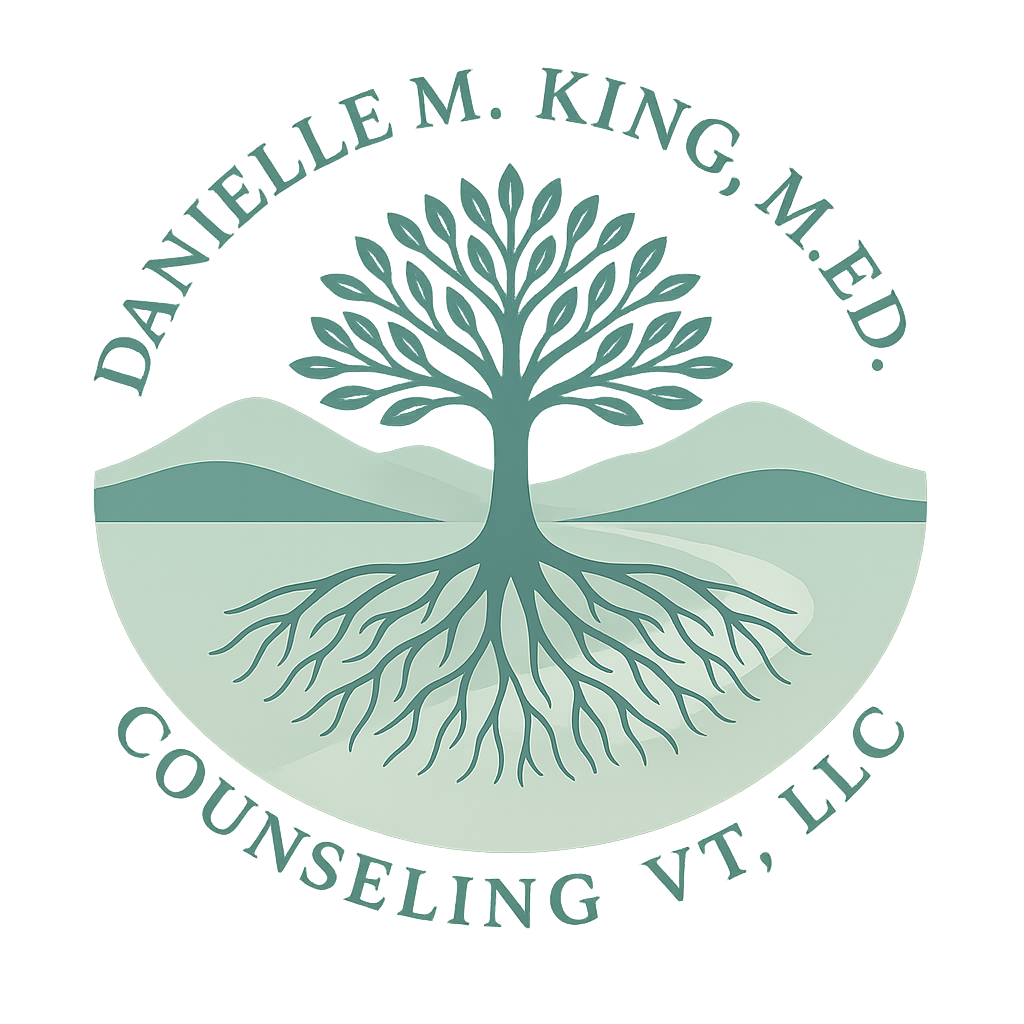Intrusive Thoughts After Birth: What No One Talks About
Understanding the hidden mental load of new parenthood—and why you’re not broken.
By: Danielle King, M.Ed. Counseling VT, LLC
Bringing a new baby into the world can be beautiful and awe-inspiring—and also deeply unsettling. Amid the sleep deprivation, hormone shifts, and identity changes, many new parents experience something that’s rarely spoken about: intrusive thoughts.
These thoughts can be disturbing, confusing, and terrifying. And because they’re so taboo, they often go unspoken—even in therapy. But here’s the truth: intrusive thoughts after birth are incredibly common, and having them doesn’t mean something is wrong with you.
What Are Intrusive Thoughts?
Intrusive thoughts are unwanted, involuntary thoughts or mental images that pop into your mind. They’re often distressing and can center around harm—especially involving your baby or yourself. Some examples might include:
Visualizing your baby falling down the stairs
Thinking, “What if I drop them?” while holding them
Imagining suffocating them while breastfeeding or during sleep
Fearing you might hurt yourself or run away
These thoughts feel jarring and out of character—and that’s part of what makes them so upsetting.
Why Do These Thoughts Happen?
Intrusive thoughts are a normal part of the brain’s anxiety response, especially during times of great change. After birth, you’re experiencing:
Hormonal shifts
Heightened responsibility
Increased vigilance (especially around safety)
Sleep deprivation
A surge in emotional intensity and uncertainty
Your mind is scanning for danger and trying to protect your baby—but it sometimes overshoots, generating scary mental content that doesn’t reflect your actual desires or intentions.
Ego-Dystonic vs. Ego-Syntonic Thoughts: What’s the Difference?
A helpful way to understand intrusive thoughts is through the lens of ego-dystonic and ego-syntonic thinking:
Ego-dystonic thoughts feel alien, unwanted, and inconsistent with your sense of self. Most intrusive thoughts fall into this category. For example, if you have a passing image of harming your baby and feel horrified by it, that’s an ego-dystonic thought. You don’t want it, and it doesn’t reflect who you are.
Ego-syntonic thoughts, on the other hand, are aligned with your values or beliefs—even if they’re harmful. For example, someone experiencing psychosis or a severe mood episode may have thoughts they accept as true or justified.
If you’re distressed by the thought, trying to avoid it, and wondering “Why would I even think that?”—that’s actually a reassuring sign that the thought is ego-dystonic, not a reflection of danger.
When Should You Be Concerned?
While most intrusive thoughts are ego-dystonic and not dangerous, there are some signs that indicate it’s time to seek immediate support:
You begin to believe the thoughts or feel they’re justified
The thoughts feel ego-syntonic, meaning they align with your beliefs or intentions
You feel emotionally disconnected from the thought and not disturbed by it
You experience compulsions (e.g., repeated checking, avoiding the baby, excessive reassurance seeking) to manage the distress
You’re having difficulty functioning—unable to sleep, eat, or care for yourself or your baby
You feel numb, emotionally flat, or have thoughts of self-harm or suicide
You’re afraid you might act on a thought
These signs may indicate postpartum OCD, postpartum depression, or—much less commonly—postpartum psychosis. Postpartum Support International (PSI) urges that any thoughts of hurting yourself or your baby that feel real, desirable, or emotionally flat should be treated as a mental health emergency.³
Getting help is not a sign of weakness—it’s a courageous step toward reclaiming safety, clarity, and connection.
You’re Not Alone—And You’re Not a Danger
Studies show that up to 90% of new mothers experience intrusive Ego-dystonic thoughts.¹ It’s a common but silent part of the postpartum experience, and one that becomes harder when met with secrecy and shame. These thoughts are not signs that you’re going to hurt your baby. In fact, the fear and discomfort you feel are signs of just how committed you are to keeping your baby safe.
What Can Help?
You don’t have to suffer in silence. Here are some compassionate strategies that can support you:
Name it to tame it
Try gently saying to yourself, “That was an intrusive, ego-dystonic thought. I don’t have to believe it or act on it.” Giving language to the experience can reduce shame and emotional intensity.
Notice the shame spiral
Intrusive thoughts often trigger self-judgment: “What kind of parent thinks this?” Remind yourself: thoughts are not actions. You are not your thoughts.
Talk to someone safe
A therapist trained in perinatal mental health can help you explore these thoughts in a safe, nonjudgmental space—and support your recovery.
Use mindfulness or parts work
In Internal Family Systems (IFS) therapy, we might explore which “part” of you is generating these fear-based thoughts, often in an effort to protect you or your child. Naming and listening to these parts with curiosity can be healing.
Know when to seek further support
If you’re starting to believe the thoughts (ego-syntonic) or feel emotionally detached from them, it’s important to seek immediate professional support. Conditions like postpartum OCD or postpartum psychosis are treatable with the right care.
Final Thoughts
Intrusive thoughts after birth are scary—but they are also normal and common. Having them doesn’t make you a bad parent. It makes you human.
You deserve a space to speak freely, to be met with compassion instead of fear, and to feel supported as you navigate the complexities of new parenthood.
If this resonates with you, I invite you to reach out or schedule a free 15-minute consultation. You’re not alone, and you don’t have to do this silently.
Danielle M. King, M.Ed.
Sources:
Fairbrother, N., et al. (2013). “Postpartum thoughts of harming the infant.” Archives of Women’s Mental Health, 16(5), 345–352.
Seleni Institute. “Perinatal Mood and Anxiety Disorders: Understanding and Treating the Spectrum.”
